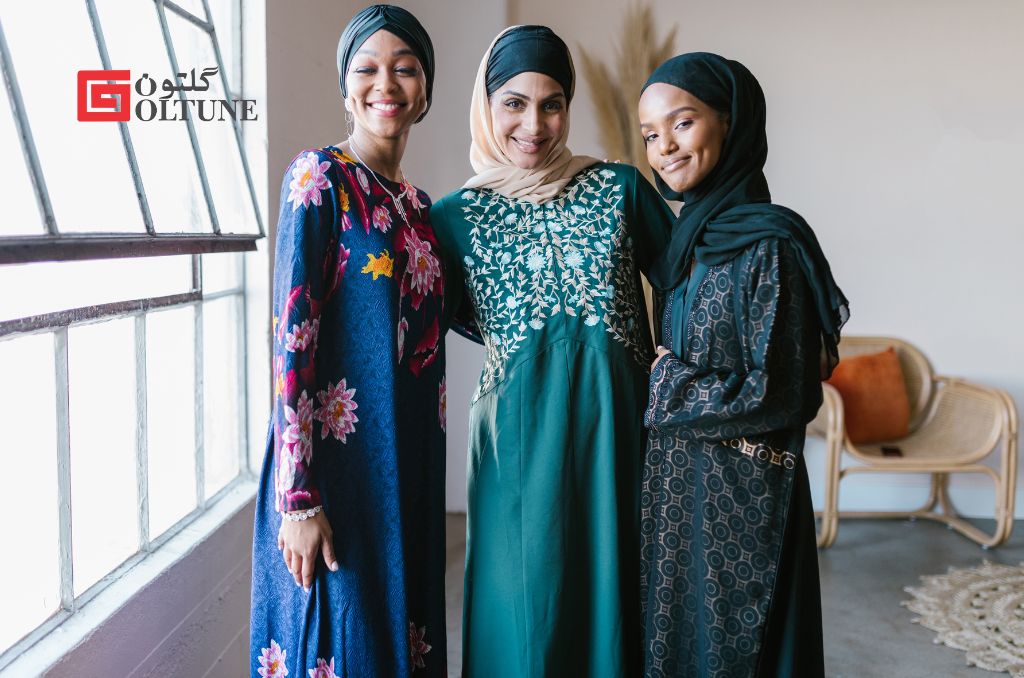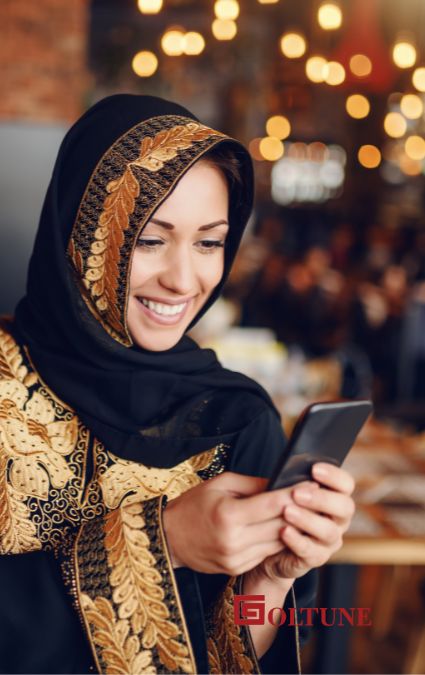
As soon as we parked and got out of the car, Shams excused himself to join his friends in the hotel’s lobby.
I helped my toddler exit the car and we went inside. I was in my usual attire, wearing a long-sleeved button-up shirt and jeans, carrying my heather backpack and toddlers’ diaper bag. I had my cotton head scarf wrapped loosely around my hair.
A smiling man in his spotless Saudi-Arabian-style long white shirt and white pants greeted us. He looked kind and handsome. “Sisters go this way,” he gestured to the door on our left, “and you brother, you go this way,” he pointed to the right. My husband and our daughter went to the men’s section.
I entered a large ballroom. The men’s and women’s sections were divided by a loose curtain between them.
I’ll never forget the shock I felt when I entered the ballroom. All the women were dressed exquisitely. They were in beautiful elaborate gowns, colorful silk silhouettes, and happy faces. Most of them covered their hair in different styles. I, undoubtedly, was the only one with no sense of style. I was a bit embarrassed.
I was a Muslim myself. I was a journalist. Yet, I didn’t know about the diversity and happiness of Muslim Americans.
It was the first time I saw so many beautiful fashions and styles for a religious Muslim ceremony.
Back in Iran, with my grandma in her mosque, all women were Shia, the second major sect of Islam. Due to the mandatory hijab that was enforced by the morality police in Iran in those years, women were only allowed to wear long robes, buttoned at the front, usually in dark colors. Or they would wrap themselves in a long black garment called a chador.
In mosques, they sometimes changed from the black chador into white ones with flower prints. The only fashion I could see in the big, social, religious public gatherings was dark and stale.
Muslim women are diverse
 But in this hotel ballroom, I saw a woman in a beautiful light pink Pakistani style long dress with matching pants and matching scarf; another woman wore a beautiful navy blue long caftan with a flower print, and a woman next to her was in a colorful orange, yellow, and light green dress. She designed her headwear like a happy rose on her head. Another woman was in a flowy, long white and black dress designed with lavish embroidery. She was wearing matching headwear styled like Turkish modern women.
But in this hotel ballroom, I saw a woman in a beautiful light pink Pakistani style long dress with matching pants and matching scarf; another woman wore a beautiful navy blue long caftan with a flower print, and a woman next to her was in a colorful orange, yellow, and light green dress. She designed her headwear like a happy rose on her head. Another woman was in a flowy, long white and black dress designed with lavish embroidery. She was wearing matching headwear styled like Turkish modern women.
I was stunned by my ignorance. I was now a journalist in the United States, yet, I had no clue about the diversity among Muslims here. What a shame.
“Where are you from?” a beautiful young woman next to me asked. “Iran,” I replied.
“Oh, we do not see many Iranians here! Welcome,” she said.
Her smile and kind manner reminded me of my grandma’s friends at her mosque back in Iran. I instantly felt at home.
“Thank you. Where are you from?” I asked. “Algeria,” she replied. “Oh, so neat. How about you sister, are you also from Algeria,” I asked the woman sitting close by. “Oh, no, I am from Egypt,” she said. “And, I am from Bangladesh,” the other woman next to them replied voluntarily. “Oh, my God, your dresses are so beautiful,” I said.
Islam and Muslims had the highest negative terms in the U.S. media compared to terms like Republican, Cancer, and Alcohol.
I was looking at dresses with a big surprise. I wasn’t aware of diversity among Muslim Americans. More surprisingly, I was a Muslim myself; I’d been living in the U.S. for about ten years by then. For more than half of those years, I worked in the media space. Yet, I didn’t know about the diversity and happiness among Muslim Americans. I wondered about the lack of information among the American public.
“This is called ‘Karakou’” the Algerian woman said. “’Karakou’ is our traditional dress,” she said with a hidden sense of pride. “Tell me more,” I replied curiously.
“In Algeria, we wear this kind of dress on national holidays and to some formal parties,” she said. She was wearing a fitted V-neck, red, velvet jacket that was decorated with beautiful golden embroidery. She sat comfortably on the ground, cross-legged, while her red satin skirt covered her legs and created room for her to maneuver to change her position. She was around 30 or 32, with a triangle-shaped face and pronounced cheekbones. I could see strings of her pitch-black hair showing from beneath her red, satin scarf.
 As she was speaking, I was thinking internally about the stories I read about Muslim women. I wondered why I had not read any stories about Muslim women’s pink scarves, orange silhouettes, different styles for their headwear, or their traditional dress. Instead, all read, especially in the New York Times or Washington Post has been about terrorism.
As she was speaking, I was thinking internally about the stories I read about Muslim women. I wondered why I had not read any stories about Muslim women’s pink scarves, orange silhouettes, different styles for their headwear, or their traditional dress. Instead, all read, especially in the New York Times or Washington Post has been about terrorism.
Because, “stories about women in the Muslim world are usually centered about one particular issue – gender inequality – at the expense of topics like art, fashion or sport” writes Rochelle Terman, assistant professor at the University of Chicago and author of Islamophobia and Media portrayal of Muslim Women.
The Western media doesn’t show Muslim happiness
Compared to all the other benchmark terms including Republican, Democrat, Cancer, Yankees, Christianity, and Alcohol, Islam and Muslims had the highest incidents of negative terms throughout the 25 years of the stories published in the New York Times, based on a study in November 2015 by 416 Labs. The New York Times still scores the most negative publication against Muslims and Islam.
Muslims stand out immediately as having the lowest percentage of articles associated with culture and education, which tend to carry a positive tone. However, stories about Muslim women, in particular, have the highest percentage associated with politics and law and order, which tend to have extraordinarily negative tones, according to the Media portrayal of Minorities Project.
Right then we heard the sound of ‘Allah Akbar’, God is the Great. I prepared to stand up. All of a sudden, I saw my daughter lift the curtain, looking for me. She saw me and rushed toward me. A few seconds later, Sid was at the women’s entrance door, looking for her. I grabbed her and went to the entrance. “She is not staying with me,” he said. “Let me take her out,” he said. “That’s OK. I got her” I said.
I took her to where I was praying. My new friends greeted her so kindly. She sat at my feet the entire time until I was done with the prayer. I had the most exhilarating, and the most colorful, Eid al-Fitr prayer.
Please Pledge to Our Peace Journalism.
Goltune is editorially independent. We set our agenda. No one edits our editors. No one steers our opinion. This is important as it enables us to stay true to our values.
Every contribution we receive from readers like you, big or small, goes directly into funding our journalism. Please support Goltune, large or small.
Send your contributions to our PayPal account: [email protected]
Or, Click the link to pledge your support.
Thank you,
Goltune Editorial Team






